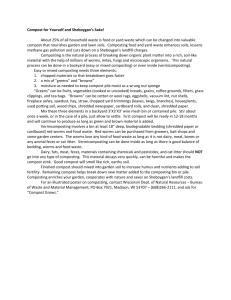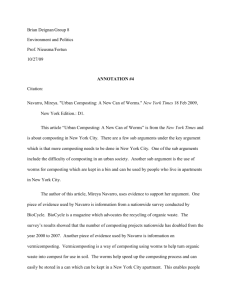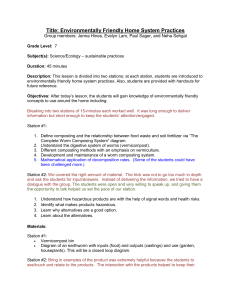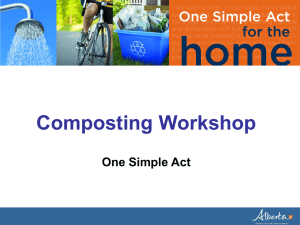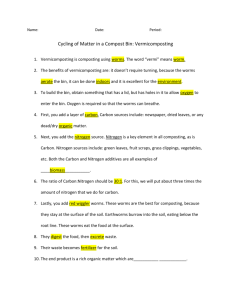Rot On! A unit on Composting and Worms Jenny Hewitt Pomfret
advertisement
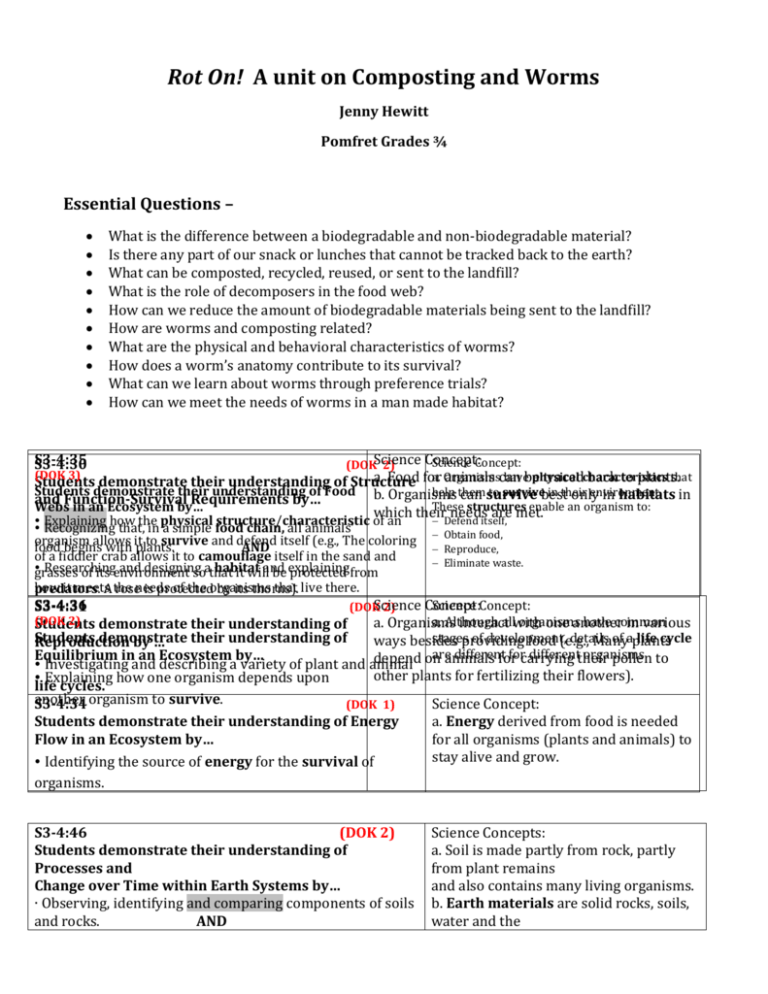
Rot On! A unit on Composting and Worms Jenny Hewitt Pomfret Grades ¾ Essential Questions – What is the difference between a biodegradable and non-biodegradable material? Is there any part of our snack or lunches that cannot be tracked back to the earth? What can be composted, recycled, reused, or sent to the landfill? What is the role of decomposers in the food web? How can we reduce the amount of biodegradable materials being sent to the landfill? How are worms and composting related? What are the physical and behavioral characteristics of worms? How does a worm’s anatomy contribute to its survival? What can we learn about worms through preference trials? How can we meet the needs of worms in a man made habitat? S3-4:35 Concept: Science Concept: S3-4:30 (DOKScience 2) (DOK 3) havebe physical that a. Food for animals can tracedcharacteristics back to plants. Students demonstrate their understanding of Structure a. Organisms Students demonstrate their understanding of Food b. Organisms help them to survive in their environment. can survive best only in habitats in and Function-Survival Requirements by… These structures enable an organism to: Webs in an Ecosystem by… which their needs are met. ∙ Explaining how the physical structure/characteristic of an ∙ Recognizing that, in a simple food chain, all animals’ organism allows it to survive and defend itself (e.g., The coloring food begins with plants. AND of a fiddler crab allows it to camouflage itself in the sand and ∙grasses Researching and designing habitat of its environment soathat it willand be explaining protected from how it meetsA the of the organisms that live there. predators. roseneeds is protected by its thorns). Defend itself, Obtain food, Reproduce, Eliminate waste. S3-4:46 (DOK 2) Students demonstrate their understanding of Processes and Change over Time within Earth Systems by… ∙ Observing, identifying and comparing components of soils and rocks. AND Science Concepts: a. Soil is made partly from rock, partly from plant remains and also contains many living organisms. b. Earth materials are solid rocks, soils, water and the S3-4:36 Science Concept: Science Concept: S3-4:31 (DOK 2) (DOK 2) a. Although allwith organisms have common a. Organisms interact one another in various Students demonstrate their understanding of Students demonstrate their understanding of stages of development, details of aplants life cycle ways besides providing food (e.g., Many Reproduction by … are different for different organisms Equilibrium in an Ecosystem by… depend on animals for carrying their pollen to ∙ Investigating and describing a variety of plant and animal other plants for fertilizing their flowers). ∙ Explaining how one organism depends upon life cycles. another S3-4:34 organism to survive. (DOK 1) Science Concept: Students demonstrate their understanding of Energy a. Energy derived from food is needed Flow in an Ecosystem by… for all organisms (plants and animals) to stay alive and grow. ∙ Identifying the source of energy for the survival of organisms. ∙ Recognizing and identifying the four basic materials of the earth (i.e., rocks, soil, water, and gases). AND ∙ Observing and comparing the properties of rocks. S3-4:49 (DOK 2) Students demonstrate their understanding of Processes and Change within Natural Resources by… ∙ Observing and describing properties of living and nonliving resources. AND ∙ Explaining how the properties of living and non-living resources make them suitable for use by humans. gases of the atmosphere. c. Rock is composed of different combinations of minerals. Large rocks can be broken down into small rocks. d. Rocks have properties of color, texture and hardness. Rocks can be classified by their physical properties. Science Concepts: a. The varied earth materials have different physical and chemical properties which make them useful in different ways, for example, as building materials, as sources of fuel, for growing the plants we use as food, or supporting animal life. Earth materials provide many of the resources that humans use. b. Earth materials have chemical and physical properties that make them useful as building materials, for growing plants, or for fuel. Assessments of Learning Compost posters and accompanying presentations to other classes Worm posters Worm Test Overview of Daily Instruction Composting Day 1 – Essential Question - What is the difference between a biodegradable and nonbiodegradable material? “What is Biodegradable” (“Do the Rot Thing” pg 3) - Students list examples of all the things they throw away, learn that biodegradable means to decay, and then sort these materials into recyclable, biodegradable, and trash. Day 2 – Essential Question – Is there any part of our snack or lunches that cannot be tracked back to the earth? “Dirt for Lunch” (“Do the Rot Thing” pg 4-5) - Students trace the origins of their snacks and lunch back to the earth. For example, bread comes from wheat, which is grown in soil. Day 3 – Essential Question – What can be composted, recycled, reused, or sent to the landfill? “Environmental Lunch” (“Do the Rot Thing” pg 6-8) - Students sort lunch and snack food and packaging materials into buckets labeled Compost, Recycle, Reuse, and Landfill Day 4/5 – Essential Question – What is the role of decomposers in the food web? “Decomposition Tag” (“Do the Rot Thing” pg 9-10) - Students play a tag game that illustrates the role of decomposers in the food web. Read Aloud – Compost Critters by Bianca Lavies “Compost Critters” (“Do the Rot Thing” pg 14-17) - Students use toothpicks and magnifying glasses to examine compost, looking for decomposers. Days 6-12 and ongoing – Essential Question – How can we reduce the amount of biodegradable materials being sent to the landfill? Part 1 - Students and teachers will build a 3-bin compost system using pallets and hardware cloth. The design is based on pg. S-7 of Scraps to Soil: A How to Guide for School Composting. Part 2 – Working in teams, students prepare posters about composting (Why compost? What can be composted? What cannot be composted? How does the system work in the classroom? How does the system work in the lunchroom?) Then they make a presentation to each class in the building. Part 3 – As a whole, the class build the compost pile, alternating greens (organic material such as food scraps) and browns (fallen leaves, hay, wood chips) Part 4 – Students maintain the compost pile by collecting compost from each classroom, the lunch room, and staff room, adding it to the compost pile, mixing in browns, and turning the pile. Worms Day 1 – Essential Question – How are worms and composting related? “The Worm Who Came to Dinner” (Worms Eat Our Garbage pgs. 56-59) This is a reading comprehension activity that draws the link between composting and raising worms to decompose household scraps. Day 2 – Essential Question – What are the physical and behavioral characteristics of worms? “Warming Up to Worms” (Critters – AIMS pgs. 40-42) Using purchased nightcrawlers, students explore the characteristics of worms. Day 3 – Essential Question – How does a worm’s anatomy contribute to its survival? “Lumbricus terrestris” (Critters – AIMS pgs. 44-47) Using a “Jigsaw” cooperative learning group, students read technical information about worm anatomy, reproduction, and movement. They then teach a new group what they learned. Day 4 – Essential Question –Can we learn more about worms through preference trials? “Wiggle Worms” (Project Seasons pgs. 91-92) Students set up preference trials to determine if worms prefer dark to light, moist surfaces to dry, etc. Day 5 – Essential Question – How can we meet the needs of worms in a man made habitat? Day 6 – Review “Wormania” video – The “Worm Lady” teaches worm anatomy, reproduction, why raising worms is helpful to the environment, how to set up a worm bin, and other interesting facts about worms. Day 7- Assessment #1 Worm Test (see attached) Days 8-9 - Assessment #2 Worm Posters (see attached checklist) Supporting Resources Songs: Banana Slug String Band Singing in Our Garden http://www.BananaSlugStringBand.com Videos: “Wormania” by Mary Appelhof Nonfiction Picture Book Read Alouds Compost! Growing Gardens From Your Garbage by Linda Glaser Compost Critters by Bianca Lavies Composting: Nature’s Recyclers by Robin Koontz Instructional Resources: Critters, an AIMS publication “Do the Rot Thing: A Teacher’s Guide to Compost Activities” PDF file available from Central Vermont Solid Waste Management District http://www.cvswmd.org Project Seasons – Shelburne Farms publication Scraps to Soil: A How to Guide for School Composting, published by Association of Vermont Recyclers Worms Eat Our Garbage: Classroom Activities for a Better Environment By Mary Applehof et al Literature Connections: How to Eat Fried Worms by Thomas Rockwell How to Eat Fried Worms activity packet and “The Bet No One Could Lose” – play performed as a Readers’ Theater both resources created by Sundance Publishers



